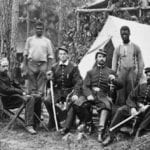 Weird Stuff
Weird Stuff  Weird Stuff
Weird Stuff  Animals
Animals 10 Inspiring Tales of Horses Being Human
 Mysteries
Mysteries Top 10 Haunting Facts About the Ghost Ship MV Alta
 History
History 10 Surprising Stories About the Texas Rangers
 Humans
Humans 10 Philosophers Who Were Driven Mad by Their Own Theories
 Miscellaneous
Miscellaneous 10 Video-Game-Worthy Weapons and Armors from History
 Weird Stuff
Weird Stuff 10 Psychics Who Accurately Predicted Wartime Events
 The Arts
The Arts 10 Pieces of Art Inspired by a Broken Heart
 Health
Health 10 Science Fiction-Sounding New Medical Treatments
 History
History 10 Surprising Facts About the Father of Submarine Warfare
 Weird Stuff
Weird Stuff 10 Times Real Laws Were Based on Bizarre Hypotheticals
 Animals
Animals 10 Inspiring Tales of Horses Being Human
 Mysteries
Mysteries Top 10 Haunting Facts About the Ghost Ship MV Alta
Who's Behind Listverse?

Jamie Frater
Head Editor
Jamie founded Listverse due to an insatiable desire to share fascinating, obscure, and bizarre facts. He has been a guest speaker on numerous national radio and television stations and is a five time published author.
More About Us History
History 10 Surprising Stories About the Texas Rangers
 Humans
Humans 10 Philosophers Who Were Driven Mad by Their Own Theories
 Miscellaneous
Miscellaneous 10 Video-Game-Worthy Weapons and Armors from History
 Weird Stuff
Weird Stuff 10 Psychics Who Accurately Predicted Wartime Events
 The Arts
The Arts 10 Pieces of Art Inspired by a Broken Heart
 Health
Health 10 Science Fiction-Sounding New Medical Treatments
 History
History 10 Surprising Facts About the Father of Submarine Warfare
10 Insane War Stories That Turned Out to Be Myths
War comes with its fair share of propaganda. On and off the battlefield, the various players try to control the narrative. Whether it’s for support in their war efforts from the masses or simply to lift the morale of those in the trenches, stories of heroes and victims are an important part of the whole charade. But sometimes, in the throws of war, real heroes emerge with stories that would shake the average human in their boots. Other times, those stories are so grand, so impossibly sensational, that you have to question whether such horrors or trials were inflated to something that has outgrown the original story or whether it even took place in the first place.
Here are ten insane war stories that turned out to be myths.
Related: 10 Often Forgotten Battles That Helped Shape the Modern World
10 Angel of Mons
When the British Expeditionary Force met the German army in Mons, Belgium, in 1914, some 75,000 men took to the field in search of an unlikely victory against an army of more than 150,000 strong.
The odds checked out, and the Germans beat back the Commonwealth army, forcing them to retreat (and recording heavy losses). Surrounded by Germans and taking heavy fire, some 4,000 soldiers found a way to return from the battlefield, prompting rumors that some sort of angelic intervention was the reason for their safe return.
Legend has it that the prayers of the soldiers were answered as a ghostly figure descended from the heavens, preventing the Germans from inflicting further harm and spooking their horses. The public took the fable as fact, and soldiers who returned from battle confirmed sightings of an angelic presence. Despite confirmation that the story was made up by a writer at the time, the legend lived on.[1]
9 German Corpse Factory
One particular form of propaganda is to make your enemy look as bad as possible—to be the terrible villain behind the worst atrocities known to man. And though you might believe war offers enough material to work with, much of what was reported was false. One such false report is the so-called kadaververwertungsanstalten or corpse factories that arose during World War I.
According to this myth, the Germans, as efficient and resourceful as they were, dedicated entire factories where they would repurpose the dead and render the bodies down. This was done so they could collect the fat, a resource that had become scarce since the start of sanctions.
The story first ran in a local newspaper, suggesting they were extracting glycerine from bodies. Then later, another article was published where eyewitness accounts of these factories suggested that the smell was similar to “burnt limes.” The public was shocked beyond reason, and attempts by the Germans to discount the claims were largely ignored.[2]
8 Ghost of Kyiv
In a war that is still raging, honest and true information is hard to come by. Still, the stories of the Ghost of Kyiv made their rounds on social media like a wildfire of hope and a symbol of the Ukrainian fighting spirit.
According to this particular myth, the Ghost of Kyiv was a fighter pilot for the Ukrainian Air Force during the early stages of the Russian invasion of Ukraine. Said to have shot down around 40 Russian fighter planes with his MiG-29 fighter jet, relying on sheer skill and willpower, stories of his antics spread the world over. Even videos showing his ferocity could be found at the height of the hype. In the end, the Ghost of Kyiv succumbed to the dangers of war.
The thing is, the Ghost of Kyiv never existed. In fact, the Ukrainians went as far as to confirm that the Ghost of Kyiv is nothing more than a figment of someone’s active imagination, raising serious questions about the spread of information in trying times. Questions should also be asked about merchandising, as the Ghost became somewhat of a hot seller with T-shirts and NFTs being sold.[3]
7 The Battle of Balaklava
The Battle of Balaklava was a somewhat disastrous skirmish between the British forces and the Russians during the Crimean War in 1854 and is made up of three main battles: The Thin Red Line, the Charge of the Heavy Brigade, and the Charge of the Light Brigade.
Much has been said about the Light Brigade and their heroic yet disastrous charge, leading to the death of 110 of 673 men, with some 130 being wounded and 58 taken prisoner. So much so that poems, books, and films have been written about the failures of military superiors, the harrowing nature of war in the 1800s, and the importance of a thought-out strategy when commencing with head-on attacks.
Although the battle was real, and the Charge of the Light Brigade was taken as a historical event recorded with relative accuracy, the impact and overall importance of the battle has, over the years, been greatly exaggerated, with some other battles featuring the sides shadowing it by gratuity and scale.[4]
6 The Lost Battalion
The story goes that during World War I, during a battle around the Argonne Forest, a battalion of men, 550 strong, fought valiantly. But in the end, the men became cut off from their forces and, therefore, isolated from support and much-needed resources while surrounded by enemy forces, with nobody knowing where they were or how to reach them.
Although much of it is fact, the truth is that they weren’t a battalion, and people (or those in charge, at least) knew exactly where they were. Made up of several different companies of the 77th Division of the American Expeditionary Forces stationed in France, the men had succeeded in capturing Hill 198. They were digging in, their neighboring forces not being successful. So the men were cut off.
Even though their own forces and the Germans knew well where they were (and moved on their position), they will forever be known as the Lost Battalion because those higher up were not kept in the loop.[5]
5 The Leaning Virgin
Also known as the Golden Virgin and the Leaning Virgin of Albert, this myth captivated so many people to the point that some believed it would determine the outcome of the entire First World War.
Found in the French town of Albert, the Basilica of Notre-Dame de Brebières was hit by enemy artillery. Yet the golden statue managed to hang on to dear life as it swung from the tower. The statue hung onto its tower over the French town for three years as the British, the French, and the Germans all invented legends for it, a common myth being that the war would end once it fell. Another suggested that whoever was responsible for its fall would be the victor.
In the end, the statue was cast off its perch by the British, who shelled the tower for unexplained reasons. The Golden Virgin was remade and reinstalled above the bell tower during its reconstruction and remains a symbol of the triumph of good over evil.[6]
4 Mystery of Celtic Wood
On October 9, 1917, in West Flanders (Belgium), 85 men from the 10th Battalion of the 1st Australian Division advanced into the Celtic Woods, most of whom were never seen again. The rest disappeared without a trace. Or did they?
The raid, as it turns out, was part of a much larger operation known today as the Battle of Poelcappelle, which was a furious and terrible engagement. The Aussies fought under British command, who decided that, in order to have a chance at defeating the German army, they would have to pull off what is called a “feint,” a minor but fierce attack to convince the Germans of a false point of attack. A ruse.
In reality, the men of the 10th Battalion were chosen as they were hardened, experienced fighters who might further enhance the mock. In other words, the men were sent to fight and die so that the army could advance. The mystery surrounding their death was nothing other than a tragic sacrifice.[7]
3 The Rescue of Jessica Lynch
When Lynch became the first woman rescued from a POW camp during the U.S. invasion of Iraq, the media was ready to put bows and whistles on every piece of the story they could find. Although Jessica was real, and her rescue was a wonder, much of the story around it was fabricated.
Suddenly Lynch was an action hero who fought off those who dared imprison her. Kindergarten teacher to soldier, a nurturing soul who also showed courage in the face of terrorism. A wonderful mix of everything a woman could be in the U.S. military.
According to false reports, Jessica suffered from multiple gunshot wounds, a broken leg, and a broken arm, all from the torture she survived. Eventually, they threw in a stab wound for good measure. By the end of it all, she was left for dead by soldiers who had killed eight of her fellow soldiers. Later, the wounds were downgraded to concussion fractures, carefully treated by a hospital in Iraq.[8]
2 The Katyn Massacre
In the early spring of 1940, the Soviet secret police murdered thousands of Poles near Katyn Forest, a short distance from the Russian city of Smolensk. However, they then blamed the Nazis.
After capturing hundreds of thousands of Polish prisoners, including some 10,000 officers, the Russians were faced with a logistical crisis—what to do with so many people. They divided the people into groups. Some were released, some were handed over to Germany, and others were placed in special camps where conditions were atrocious.
It is unclear how many died, but estimates suggest that over 20,000 people lost their lives. The Red Army pinned the responsibility squarely at the feet of the Germans, and the Western countries believed them. Many years later, the truth is still being discovered.[9]
1 Kuwait Incubator Babies
In October 1990, a story hit news headlines of Iraq soldiers committing terrible acts against the people of Kuwait.
As the story goes, so-called eyewitnesses saw soldiers storm a hospital, taking babies out of incubators, stealing the incubators, and leaving the children on the cold floor to die. The report sent shockwaves through the American public, leaving many baying for blood. Testimonies of the events even made their way to Congress, and in 1991, Congress authorized the use of force against Iraq. The Gulf War had begun.
The crazy thing is, it was made up. The reports of the incubator babies were later confirmed as nothing but a farce staged by U.S. politicians as a means to their own political ends by way of manipulation of public opinion.[10]








